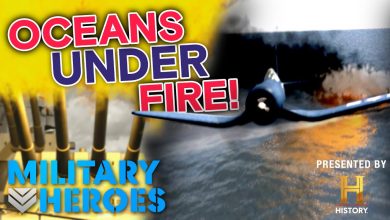Christensen Evoke 7mm Backcountry Rifle Review
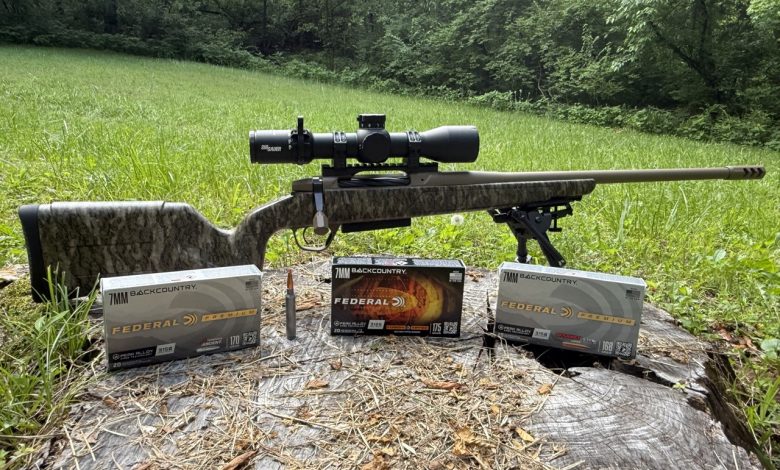
Long-range hunting has historically been the domain of custom rifles with eye-watering price tags, but the landscape is changing.
The Christensen Evoke represents a significant shift toward more affordable long-range hunting rifles, especially when chambered in the versatile new 7mm Backcountry cartridge. Let’s examine how this combination, paired with quality optics, creates a formidable hunting system without breaking the bank.
The new Christensen Evoke stands as a testament to the company’s commitment to bringing premium features to more attainable price points. Built on a proprietary action machined from billet steel, the Evoke incorporates the precision engineering Christensen is known for while making calculated compromises to reduce cost.
Unlike their flagship models with carbon fiber barrels, the Evoke features a match-grade stainless steel barrel with a proprietary Cerakote surface treatment. This 20-inch barrel with its 1:8″ twist rate strikes an ideal balance for the 7mm Backcountry cartridge, stabilizing the heavier projectiles preferred for long-range hunting. Despite the shorter barrel length, the efficient 7mm Backcountry cartridge is advertised to push all tested factory loads beyond the coveted 3,000 fps sweet spot. On this velocity threshold, 7mm bullets achieve their optimal balance of flat trajectory, retained energy, and terminal performance.
The rifle’s carbon-fiber reinforced polymer stock deserves special mention. While not as light as full-carbon offerings, it maintains excellent rigidity while reducing overall weight to 7.3 pounds—significantly lighter than traditional hunting rifles with similar capabilities. A standout feature is the ergonomic vertical grip design, which promotes proper trigger control and provides more natural wrist alignment.
This vertical orientation also facilitates a more consistent and repeatable grip angle, enhancing shot-to-shot precision, especially during off-hand shooting or in awkward field positions. The raised cheek comb and length-of-pull spacers allow for a proper fit without requiring gunsmithing, completing a thoughtfully designed stock system that balances comfort, function, and affordability.
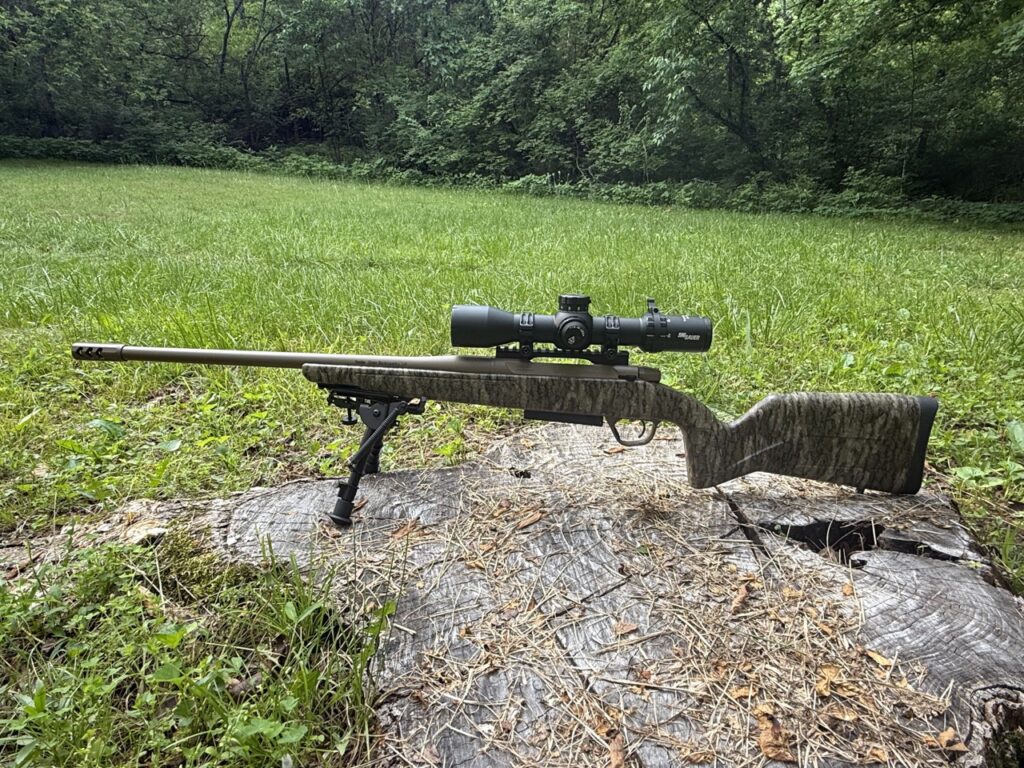
The Evoke’s TriggerTech trigger breaks cleanly at an adjustable 2.5-3.5 pounds, providing the crisp, predictable release essential for precise shot placement at extended ranges. The three-lug bolt with its 70° throw and smooth operation further enhances the shooting experience, while the detachable magazine system offers convenience in the field.
The rifle comes equipped with an effective muzzle brake that significantly reduces felt recoil by 40-50%, making the already manageable 7mm Backcountry even more comfortable to shoot. This recoil reduction enables faster follow-up shots and improved observation of bullet impact.
However, the brake comes with a notable trade-off: it substantially increases the rifle’s report and blast signature, which can be problematic for hunting situations where noise is a bigger factor. Many hunters find the increased noise uncomfortable without hearing protection and potentially disruptive to game in the area. Consequently, a significant number of hunters opt to replace the muzzle brake with a suppressor, which provides similar recoil benefits while reducing rather than amplifying the rifle’s sound signature.
Federal’s team of engineers set out to design a cartridge that answers a market need that seemed unsolvable—magnum velocity out of shorter barrels without increasing recoil. They did, but in the process, they produced true innovation, creating a new way to make rifle ammunition faster, flatter shooting, and more powerful. Powered by Peak Alloy case technology, the 7mm Backcountry can be loaded to higher chamber pressures than brass case counterparts.
The cartridge’s primary goal is to consistently drive high ballistic coefficient 7mm bullets above the critical 3,000 fps threshold—a velocity that ballistics experts consider the sweet spot for 7mm hunting projectiles. At this velocity, 7mm bullets achieve an optimal balance of flat trajectory, wind resistance, energy retention, and terminal performance. The 7mm Backcountry also strives to maintain this performance edge even in shorter barrels, a significant advantage for hunters who prefer more maneuverable rifles in field conditions.
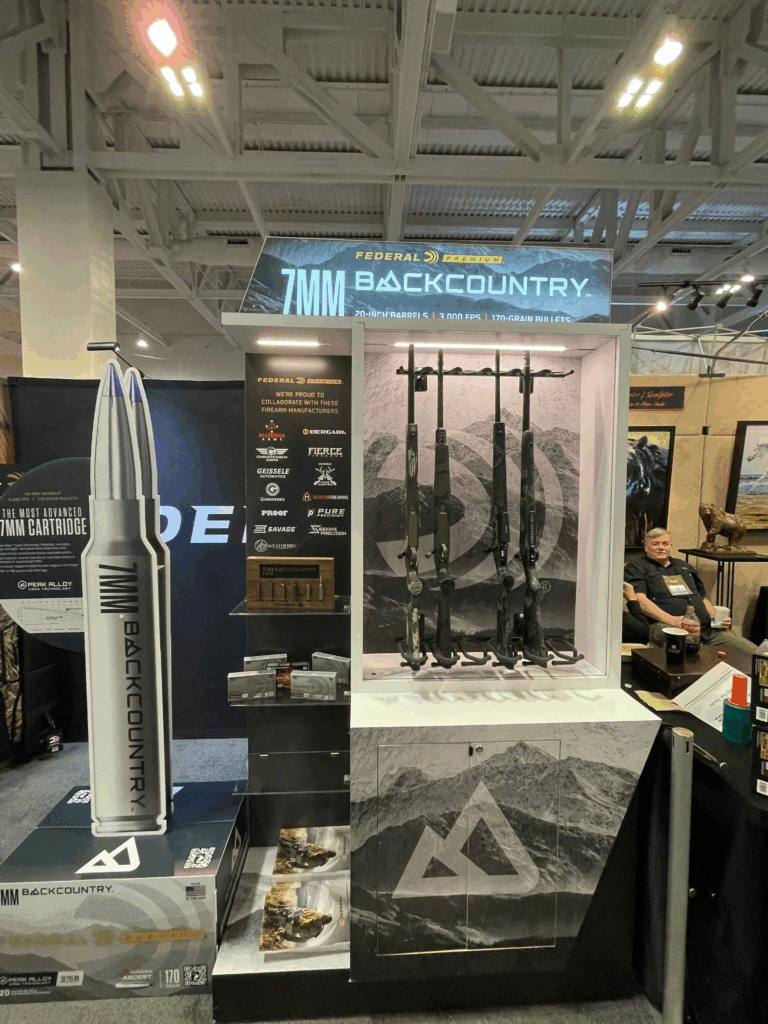
The 7mm Backcountry aims to become a favorite among hunters who demand the best in performance, accuracy, and versatility. With a trajectory flatter than traditional hunting rounds and energy retention superior to many competitors, the 7mm Backcountry effectively bridges the gap between conventional hunting cartridges and larger specialized long-range options.
This partnership between rifle and cartridge yields sub-MOA accuracy with 3-shot groups—exceptional for a production hunting rifle in this price range. Factory ammunition availability, initially limited, has expanded as dealers recognize the cartridge’s potential among western hunters. I’m pretty excited about this cartridge and the new case technology, despite some of the early obstacles it will likely face. For example, reloaders are eager for Federal to release reloading data and information on tools and specifications, and many will wait to try it until then.
No long-range system is complete without quality glass, and the Sig Sauer Tango DMR 3-18x44mm with the Dev 2.0 illuminated reticle represents an excellent performer in premium optics. The 34mm main tube allows for a generous internal adjustment range, critical for taking full advantage of the 7mm Backcountry’s long-range capabilities.
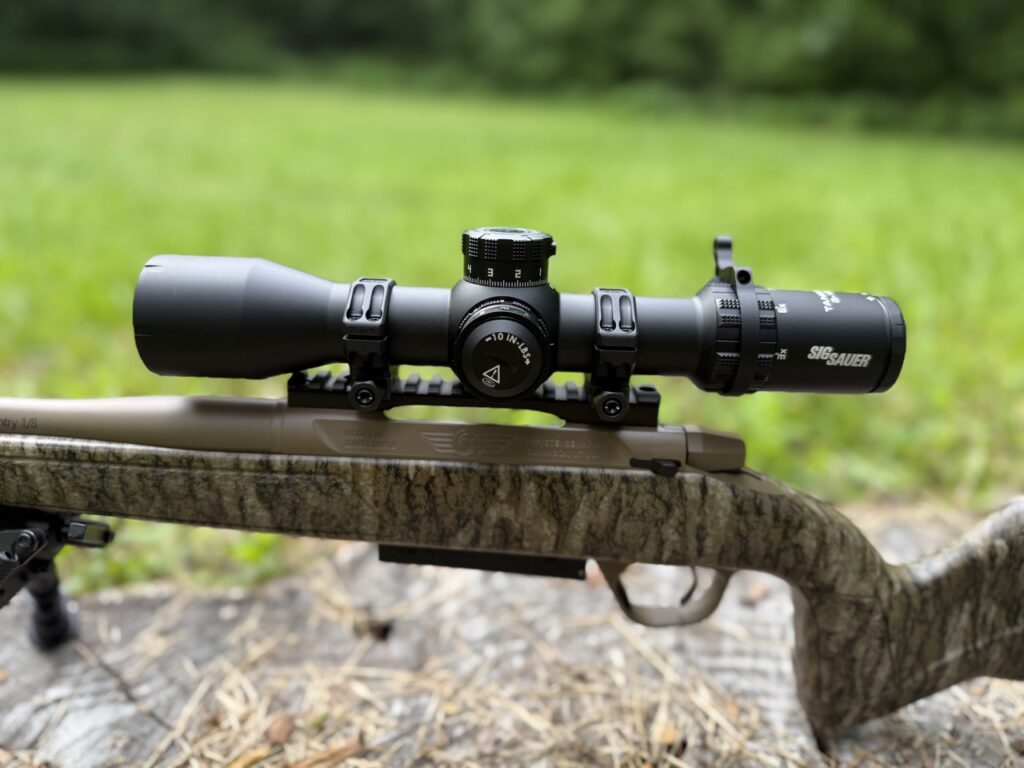
Edge-to-edge clarity is excellent across the entire magnification range, thanks to the HD glass, which provides exceptional resolution and contrast even in challenging lighting conditions. The zero-stop turrets offer positive, tactile clicks with a zero-stop and lockable zero-return feature that inspires confidence in field conditions. The 25.5 oz weight is also impressive for this level of optical performance, and makes it a great fit for a backcountry hunting setup.
The first focal plane reticle design ensures that holdover and ranging references remain proportional throughout the magnification range. The Dev-L 2.0 reticle with its illuminated center provides quick target acquisition in low light while offering precision aiming points for wind and elevation holds when time doesn’t permit dialing adjustments.
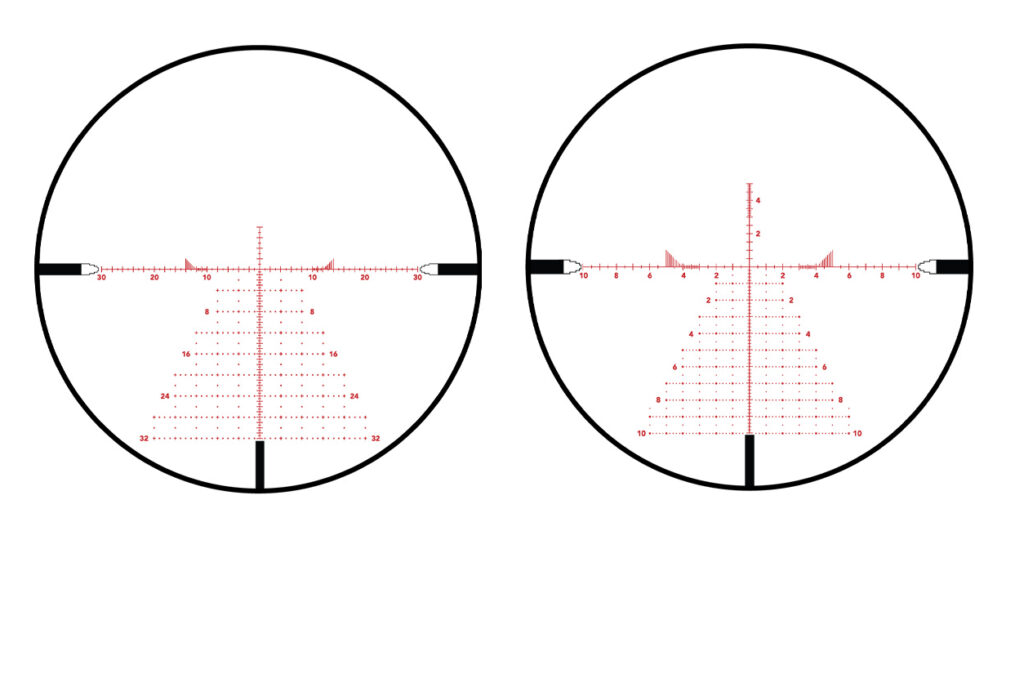
While not inexpensive at $1,099.99 MSRP, the Tango DMR represents the sweet spot where significant additional expenditure often yields diminishing returns in optical performance. When paired with the Evoke rifle, the combination delivers capabilities that would have required custom builds costing twice as much just a decade ago.
Testing four different factory loads from Federal revealed interesting performance characteristics. It provided insight into both the rifle’s capabilities and the 7mm Backcountry cartridge’s real-world ballistics compared to manufacturer claims. All testing was conducted using at least three 5-shot groups at 100 yards under normal conditions.
Understanding Mean Radius vs. Extreme Spread
Before diving into the specific ammunition results, it’s worth explaining two different methods for measuring group accuracy. Most shooters are familiar with extreme spread—the traditional measurement from the center of the widest two holes in a group. A traditional 5-shot group is a common example of extreme spread. However, mean radius provides a more statistically meaningful representation of a rifle’s true precision.
Mean radius measures the average distance of all shots from the geometric center of the group, providing a better indication of where the majority of shots will land. While a single flyer can skew the extreme spread, the mean radius gives you a clearer picture of the rifle’s consistent performance. Think of it this way: if you’re a hunter, you care more about where most of your shots will go rather than being penalized by one outlier that opened up an otherwise tight group.
For practical purposes, a rifle with a 0.5-inch mean radius will put roughly 63% of its shots within a 1-inch circle at 100 yards—valuable information for understanding real-world hunting accuracy. An under 0.3-inch mean radius is typically considered excellent for a match-grade precision rifle. I used Hornady’s Groups Analysis program in their app to measure the mean radius on all the groups.
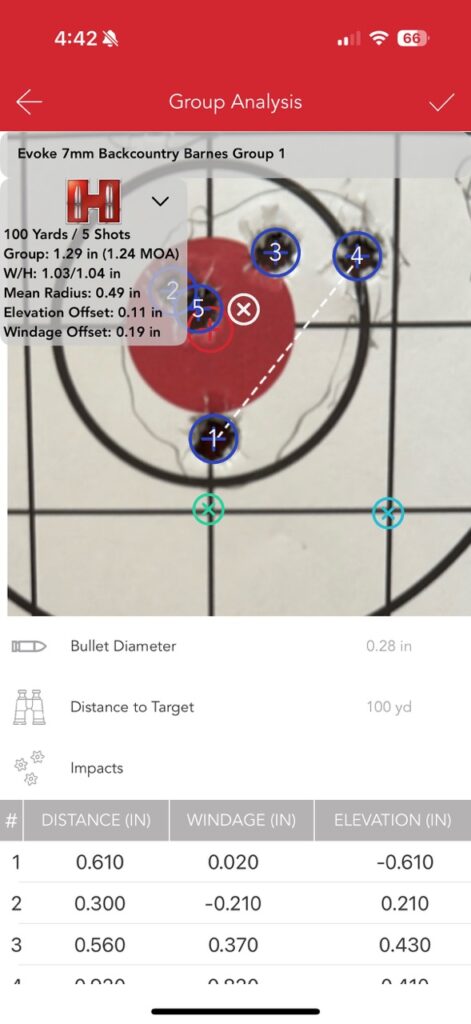
Barnes LRX 168 grain
The Barnes LRX 168-grain load averaged 1.417-inch five-shot groups with a mean radius of 0.667 inches. Velocity testing yielded an average of 3,020 fps—falling short of the 3,150 fps box claim but maintaining the desired performance threshold of 3,000 fps or higher.
The all-copper construction of the Barnes bullet ensures 100% weight retention, making it an excellent choice for hunters in lead-free zones or those prioritizing deep penetration. Despite having the largest mean radius of the traditional hunting bullets tested, the difference is marginal and well within acceptable hunting accuracy standards out to 500-600 yards.
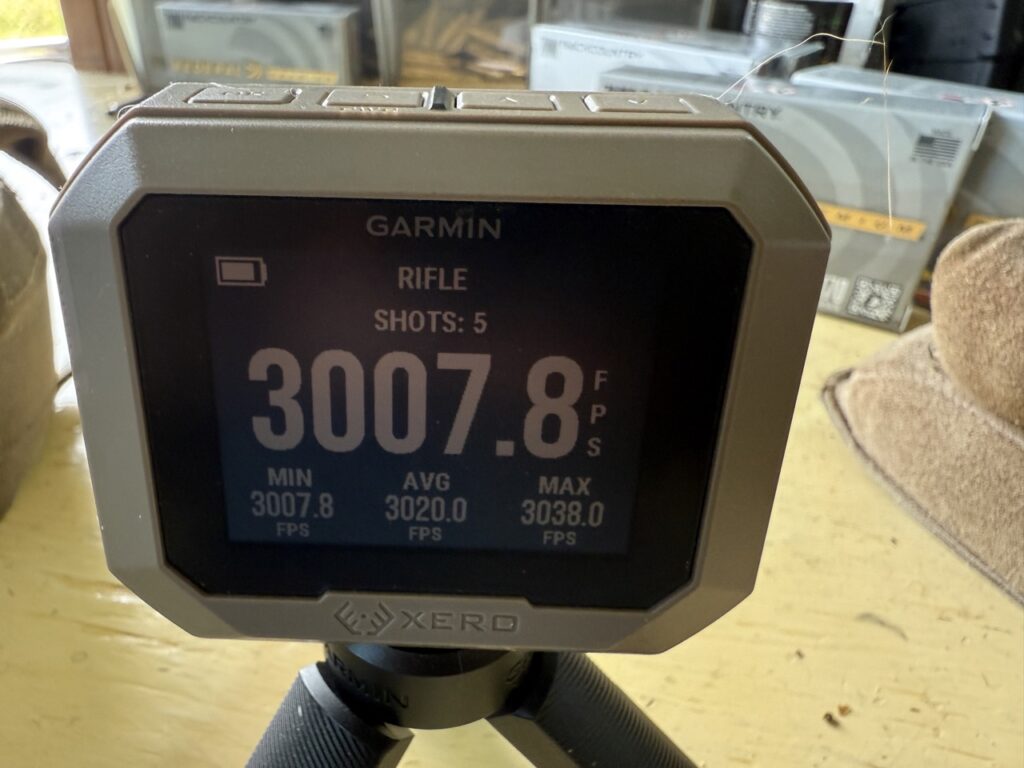
Terminal Ascent 170 grain
The Terminal Ascent 170-grain load produced five-shot groups averaging 1.432 inches with a mean radius of 0.561 inches. Chronograph testing revealed an average velocity of 3,034 fps—again below the 3,150 fps advertised on the box, though still comfortably above that coveted 3,000 fps threshold.
Even with the velocity reduction, this load delivered excellent terminal ballistics characteristics, maintaining over 1,500 ft-lbs of energy well beyond 600 yards. The bonded construction and polymer tip combination make this a solid choice for medium to large game.
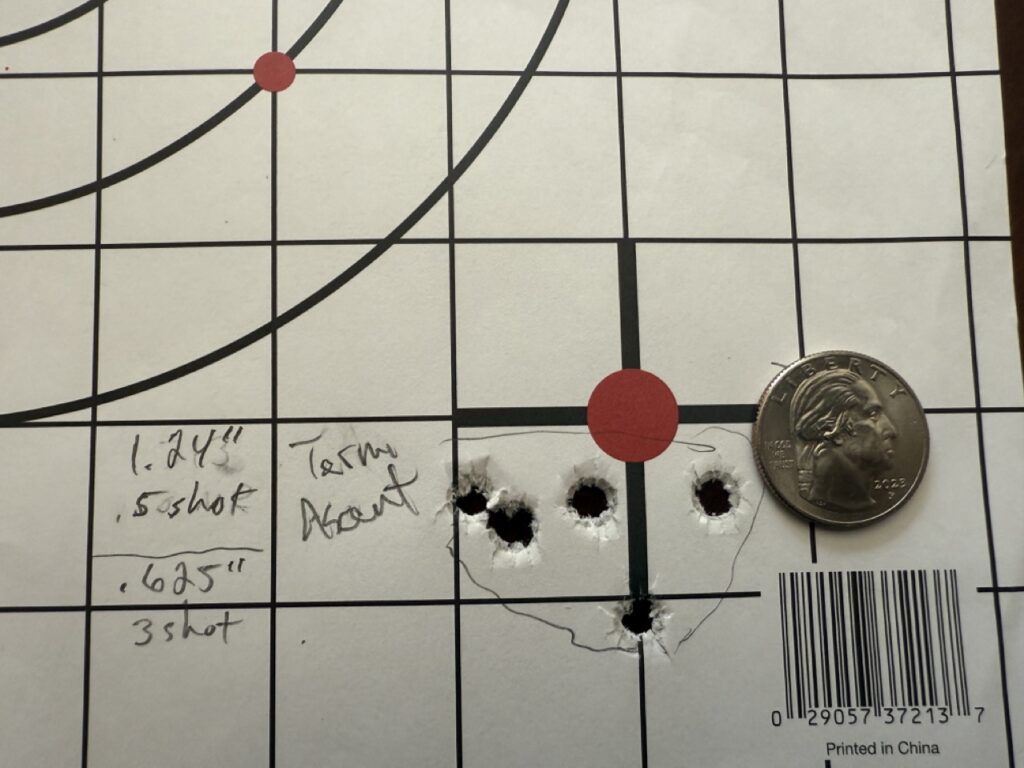
Fusion Tipped 175 grain
The Fusion Tipped 175-grain offering produced similar group sizes, averaging 1.410 inches with a mean radius of 0.643 inches. Velocity averaged 2,962 fps, falling short of the advertised 3,125 fps but still delivering solid downrange performance.
This slight velocity deficit didn’t significantly impact practical performance, as the higher sectional density of the 175-grain bullet maintained excellent energy retention. The electrochemically bonded construction proved reliable across a wide range of velocities, and the slightly larger mean radius still represents hunting-grade accuracy for most practical applications and ranges.
Berger Elite 195 grain
Here’s where things got really interesting. The heaviest bullet tested, Federal’s 195-grain Berger Elite load, delivered the most impressive accuracy results, with 5-shot groups averaging just 0.923 inches and an outstanding mean radius of only 0.333 inches. This represents genuinely precision-rifle accuracy from a hunting platform.
Velocity averaged 2,840 fps—below the advertised 3,000 fps but in proportion to the actual speed of the other loads. What the Berger load lacks in raw velocity, it more than compensates for with exceptional ballistic coefficient and downrange performance. The mean radius results suggest this rifle has a definite preference for the longer, heavier projectiles that the 1:8″ twist rate was designed to stabilize.
The Berger Elite’s performance was so impressive it almost seemed like a different rifle was being tested. Groups were consistently tight, with minimal flyers, resulting in that excellent mean radius measurement. For hunters prioritizing precision over raw velocity, or those planning shots beyond 600 yards where the high BC really shines, this load represents the clear accuracy winner with the rifle I tested.
Extended-range testing revealed some interesting characteristics of the Evoke’s performance with the 7mm Backcountry cartridge that warrant further commentary. Three-shot groups consistently averaged an impressive 0.491 inches across all four ammunition types—exceptional accuracy for a production hunting rifle in this price range. However, expanding to five-shot groups showed a notable increase to an average of 1.40 inches for all loads except the Berger Elite, which is more pronounced than what I usually see in testing other cartridges. The higher chamber pressures associated with the 7mm Backcountry cartridge could be causing some accuracy degradation as the barrel heats up, similar to what experienced handloaders have observed when working with maximum or near-maximum pressure loads.
This accuracy characteristic has practical implications to consider for different shooting applications. For big game hunting scenarios where 1-2 shots are typically taken individually with time between opportunities, the excellent three-shot accuracy makes this cartridge entirely suitable for field use. The sub-half-MOA precision would provide confident shot placement on game animals at extended ranges.
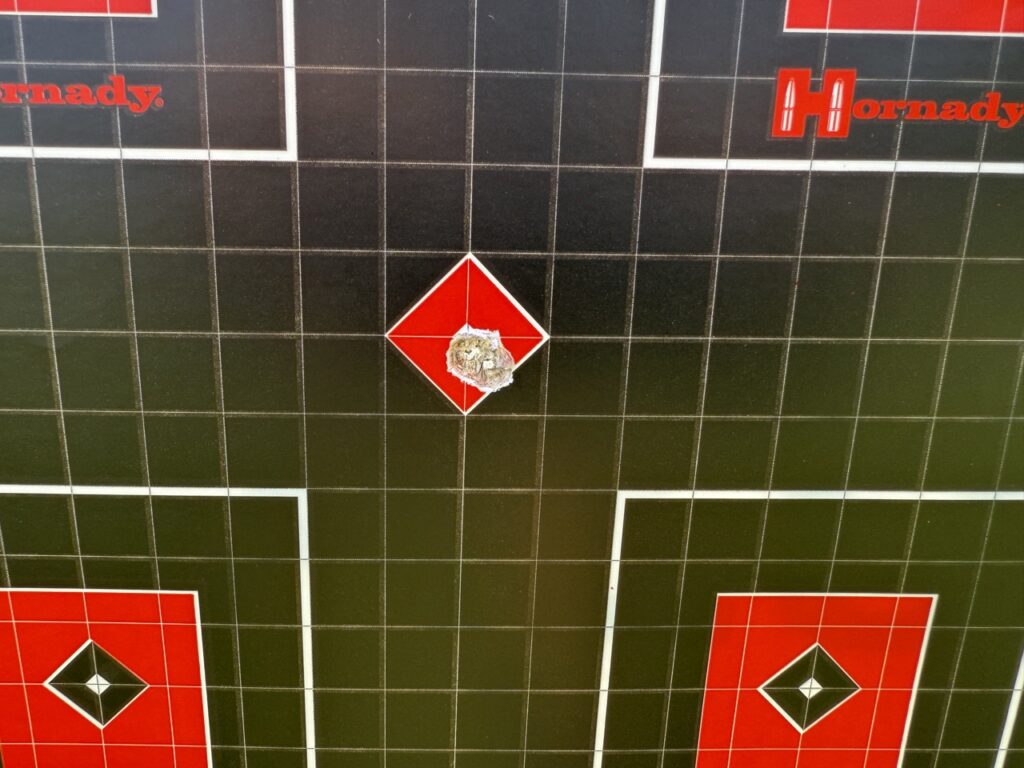
However, the five-shot group expansion raises questions about sustained accuracy during high-volume shooting situations. For competitive applications like NRL Hunter or PRS matches where higher round counts and rapid engagement sequences are common, this could prove quite challenging. The accuracy degradation may affect performance in stages that require multiple consecutive shots without adequate cooling time. With that said, the Berger Elites might work well with the higher round counts.
Further testing with two additional rifles chambered in 7mm Backcountry demonstrated similar results of excellent three-shot precision followed by group expansion in five-shot strings or more, with the majority of the ammunition tested. This data is valuable for hunters and competitive shooters considering this cartridge for their specific applications, as it suggests the phenomenon could be inherent to the cartridge’s high-pressure characteristics rather than individual rifle quality. We’ll continue to learn more about the new technology in this cartridge as more rifles are tested, and I wouldn’t be surprised to see Federal make improvements to the ammunition.
Field testing across varied terrain and weather conditions confirmed the system’s practical hunting capabilities. The rifle’s moderate weight of 7.3 pounds remained comfortable during extended stalks. The stock design and manageable recoil of the 7mm Backcountry allowed for stable shooting even in awkward field positions.
Accuracy testing at ranges from 300-600 yards consistently produced vital-zone hits on 10-inch steel targets with relative ease. The optical clarity of the Sig Tango DMR proved especially valuable in early morning and late evening lighting conditions typical of hunting scenarios.
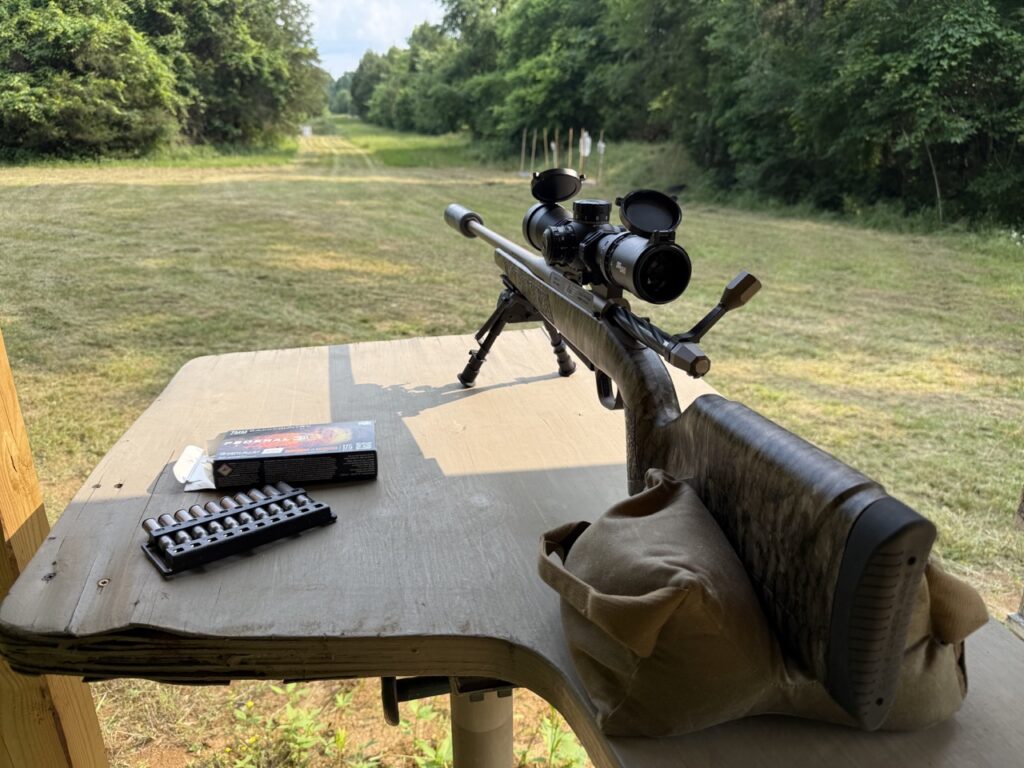
The rifle’s balance point and overall handling characteristics made it well-suited for the varied demands of backcountry hunting. While not as compact or lightweight as some specialized mountain rifles, the 20-inch barrel and moderate weight provide an excellent compromise between maneuverability and shootability. Last, I didn’t encounter any feeding or reliability issues with firing the higher-pressure cartridge in the Evoke.
The Christensen Evoke in 7mm Backcountry, paired with the Sig Sauer Tango DMR 3-18x44mm scope and quality ammunition, represents an exciting innovation of long-range hunting capabilities in a compact setup. This combination delivers features and performance that would have required custom builds with much higher price tags just a few years ago. The practical hunting accuracy, terminal performance, and overall design are impressive at such an affordable price.
This new cartridge, rifle, and scope mark a positive shift in the backcountry hunting market, offering enhanced capabilities to more hunters while maintaining the quality and performance necessary for consistent success in the field. Whether pursuing big game across western expanses or simply wanting to extend effective range and maneuverability, this setup is a great example that premium performance doesn’t always require premium prices.
Christensen Evoke Rifle Specifications
- Caliber: 7mm Backcountry
- Action: Proprietary billet steel bolt action
- Barrel Length: 20 inches
- Barrel Material: Match-grade cerakoted 416R stainless steel
- Twist Rate: 1:8″
- Overall Length: Approximately 40 inches
- Weight: 7.3 pounds
- Stock: Carbon-fiber reinforced polymer with vertical grip design
- Adjustability: Adjustable cheek riser (precision model) and length-of-pull spacers
- Trigger: TriggerTech, adjustable 2.5-3.5 pounds
- Bolt: Three-lug design with 70° throw
- Magazine: Detachable box magazine
- Muzzle Device: Included RFR muzzle brake
- Threading: Standard 5/8×24 for suppressor compatibility
- MSRP: Starting at $898.99
- Website: www.christensenarms.com
Where To Buy

Sig Sauer Tango DMR 3-18×44 Specifications
- Magnification Range: 3-18x
- Objective Lens: 44mm
- Tube Diameter: 34mm
- Reticle: Dev 2.0 Illuminated (First Focal Plane)
- Turrets: Zero-stop with lockable zero-return
- Glass Type: HD (High Definition) glass
- Eye Relief: Generous across magnification range
- Adjustment Range: 45 MRAD elevation adjustment
- Construction: Aircraft-grade aluminum
- Waterproof/Fogproof: Yes
- Illumination: 11 brightness settings
- Click Value: 0.1 mil adjustments
- Weight: 25.5 ounces
- MSRP: $1,099.99
- Website: www.sigsauer.com
Where To Buy
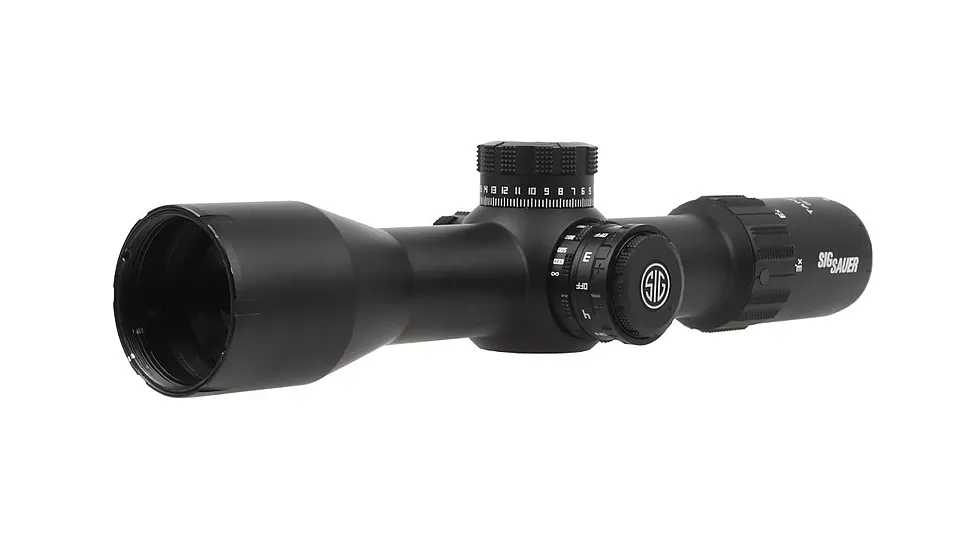
Read the full article here





